A Leyyer to Families on Recycling for Teaching Strategies
one. Introduction
Sustainable evolution is considered a relevant and disquisitional effect in contemporary societies [one,ii,3,iv,5]. In the field of teaching, special attention has been paid to sustainability [4,6,vii,8]. Knowing that sustainable development is oft considered to be an integrated concept with three pillars (environmental, economic, and social [9,10]), this newspaper focuses on environmental issues. Moreover, the enquiry full-bodied on didactics for sustainable development in early childhood [eleven,12], and particularly on the habit of recycling (see Figure ane), every bit this is a do necessary to avoid the depletion of natural resources. Furthermore, different studies have shown that children tin can engage with ideas related to the surroundings when the issues connect mightily with localized experiences, such as recycling.
Teaching most the environment highlights the individual's active participation and contribution in coping with ecology problems and making sustainable choices [thirteen]. However, despite the efforts made to increment people's awareness, skills, and sensitivity toward caring for the environs, there are doubts about the effectiveness of some of these programs and whether they contribute to sustainability [14]. It has been found that noesis does not easily lead to a change in behavior [15,16]. On the other hand, it seems that these programs take overlooked children as relevant stakeholders [17] and that environmental educational activity researchers did non direct their interest to very young children until 2007 [18,19]. Besides, according to Iliopoulou [xx], research studying very young children's understanding of waste management has shown that nigh of them regard waste matter disposal and recycling as others' responsibility, and but a minority in that report talked well-nigh action.
For all of these reasons, this study aimed to define and implement a education unit that develops the habit of recycling in early babyhood past focusing on a physical sustainable practice: aluminum packaging recycling. Aluminum was chosen for several reasons. Firstly, it is a material that children are familiar with because they see and apply it most every twenty-four hour period (foil wrapping for sandwiches, yogurt lids, pouches, etc.). Secondly, recycling aluminum creates significant environmental advantages, such every bit reducing consumption of the mineral bauxite and reducing energy consumption by 95% when manufacturing new products. Thirdly, aluminum can be recycled indefinitely without losing its attributes. The corporeality of aluminum packaging that is recycled should be increased in Spain in club to achieve the rates established by European regulations: l% before 2025 and 60% before 2030 (https://eur-lex.europa.eu/eli/dir/2018/852/oj) [21].
Thus, this study had the post-obit research objectives:
1. Make up one's mind the levels of knowledge, sensation, and beliefs that teachers, children, and parents have about sustainability in general and the recycling of aluminum packaging in particular;
2. Train teachers to design a teaching unit that educates children about sustainability in general and the recycling of aluminum packaging in detail; and
3. Assess the effectiveness of the aluminum packaging recycling programme for teachers, children, parents, and preschools.
We approached our research questions according to this sequence. Starting time, our purpose was to assess managers' willingness to participate in educational programs to promote sustainability to children. Second, through the implementation of workshops, we trained teachers about sustainability in general and the recycling of aluminum packaging in particular. According to Varela-Losada, teachers play a primal role, especially given the transition toward schools and communities committed to the environment and people [22]. Tertiary, seven teachers developed and implemented a teaching unit to involve children and families in recycling activities.
This newspaper is organized equally follows: first, we present the framing used to conceptualize early education on sustainability. So, we describe the methodology. The results are presented subsequently. Finally, nosotros engage in a more in-depth discussion, providing some concluding remarks and implications for future research.
2. Didactics for Sustainable Development in Early on Childhood
The application of education for sustainability practices in early childhood has progressed slowly [23]. While information technology is truthful that sustainable development deals with abstract and complex relationships that are especially difficult for children [24], many authors have stressed the importance of environmental education, and some say that education in environmental sustainability should starting time in babyhood [18,25,26,27,28,29]. In improver, early babyhood instruction could play an essential office in sustainable practice, as it is considered to exist a menstruation of time when children's main attitudes and values are established for the showtime time [27,30,31,32,33]. According to Davis [12], the experiences provided for young children are influential to their present and hereafter beliefs, values, well-existence, and individual and social development. Furthermore, children correspond the interface between current and future generations [17].
In terms of early on childhood sustainability educational activity, attention to experiential learning is central and lies at the middle of early on childhood educational activity [33]. Learning through games and agile exploration of the environment has been considered a characteristic of early learning [34]. Besides, cooperation between families and preschools appears to be a critical element when trying to obtain long-term benefits [35]. MacDonald [36] has highlighted that early babyhood sustainability instruction should be promoted through active, collaborative, project-based methods rooted in cocky, family, schoolhouse, and community. Chauhan, Rama Das, Haigh, and Rita [37] pointed out that pro-sustainability orientation includes irresolute habits and making sustainable choices as a matter of daily routine.
Additionally, there is room in the preschool setting to build connections with and participate in the customs around them and to accept reward of physical and social resources in the commune. This view is incorporated inside identify-based education, in which children learn to understand, value, and care for the heritage, culture, and landscape of the place where they alive. As Luff points out [33] (p. 453) (later several studies), "Children who have opportunities to explore, connect with, and appreciate the places where they live develop a sense of care for self, others, and the environment. This tin can pb to piece of work on local social and ecology projects and growing appreciation of wider national and global problems." In summary, the literature recognizes the necessity of organizing experiences in early babyhood environmental education that let for maximum interaction and advice between teachers, children, and their families [38].
From the point of view of teaching, post-obit Loubser et al., "The implementation of ecology education programs and activities conducted by teachers for their own students would seem advantageous in ensuring both continuity and the positive impacts of environmental pedagogy programs on school students, as teachers are familiar with the curricula and the time availability of students" [xiv] (p. 1165). Furthermore, it was institute that to implement environmental instruction, it is necessary not simply that teachers know how to brainwash young children, only likewise that they know general concepts of sustainability [38]. Therefore, governments and international organizations must provide the means for this to happen [35]. Moreover, according to Hopkins and McKeown [39], it is necessary that nonformal organizations and the private sector support formal education to ensure effectiveness in sustainable living. In this study, this is the role of the association that promotes aluminum packaging recycling in Spain (Arpal). Arpal provides people as facilitators and program developers. Experts from Arpal can also provide additional knowledge and active methodology so that teachers become sustainability leaders within their schools. According to Kennelly, Taylor, and Maxwell [twoscore], when values and beliefs about the bug associated with sustainability are strong, they become role of the teacher'due south identity and provide a personal motivation to incorporate those values into their education.
All of the ideas and noesis obtained from a review of the literature were considered in the enquiry that follows.
3. Materials and Methods
The goal of this research was to study whether the teaching unit of measurement could contribute to fostering recycling habits in early childhood. As has been said before, usually verbal persuasion is not plenty to encourage children to act positively to protect the environment [41]. Moreover, information technology seems that one of the nearly crucial challenges in didactics for sustainable development is didactic [42]. Thus the researchers thought that a teaching unit of measurement with active learning activities that develop under multiple skills could take a ameliorate impact on children's behavior by focusing on a physical sustainable practise: aluminum packaging recycling.
The education unit of measurement was designed by seven teachers that were then responsible for the implementation of a pilot examination developed in two preschools in Córdoba and one in Seville (with an average of 18 children in each preschool) to assess its efficacy. The teachers belonged to the association Supla (http://suplasl.es), which promotes social and solidarity economy. The research took place with the collaboration of Arpal, which was in accuse of training teachers in aluminum packaging recycling problems and of the supervision of technical issues related to the content of aluminum. On the other hand, the touch that the teaching unit had on the preschools and the families was also evaluated. After this exploratory inquiry, the teaching unit was implemented in 29 Andalusian preschools, with a full of 1300 children participating in the written report.
3.1. Phases and Research Tools
3.ane.1. Diagnosis
The goal of the commencement phase was to find out the level of noesis, awareness, and behavior that children nether 6 years quondam (mainly ii and iii years old), parents, and teachers had before the program.
For the teachers, a questionnaire was prepared to assess three parameters: four questions tested knowledge well-nigh recycling and about aluminum packaging, three most awareness, and two well-nigh behavior. This questionnaire was answered before the training that Arpal offered to teachers in Nov 2017. The survey questions included the following:
-
Q1: Do you know what cloth goes into recycling containers that are green, yellow, and blue?
-
Q2: Can you lot mention packaging fabricated of aluminum?
-
Q3: Do yous know in which container aluminum packaging must be placed in lodge to be recycled?
-
Q4: How important do you consider your participation in aluminum packaging recycling to be?
-
Q5: Why do you consider your participation in aluminum packaging recycling important (or non)?
-
Q6: Who benefits if you recycle aluminum packaging?
-
Q7: Practise you lot recycle some of the following materials at dwelling or in the workplace: beverage cans, bricks, aluminum packaging, foil paper, or other packaging fabricated of metal?
-
Q8: Do y'all teach about waste recycling in the classroom?
-
Q9: Have you always heard about a circular economy?
To determine children's knowledge, teachers tested v parameters at the beginning of the teaching unit: knowledge of the containers for recycling, attitudes toward recycling, inventiveness when working with recycled cloth, the classification of packaging before recycling, and noesis about where aluminum packaging must be placed in order to be recycled. They retested the aforementioned parameters at the end of the teaching unit.
Concerning parents, the research of Ballantyne, Fien, and Packer [43] was followed. In that study, some parents announced that talking about environmental topics tin aid alter children's attitudes and behaviors. In addition, Grodziéska-Jurezask et al. [44] showed that the behaviors of parents have a significant impact on children's knowledge of and attitudes toward the environment. For these reasons, the preschool sent a letter to the parents informing them nigh the teaching unit. Families were invited to participate in the activities with their children and were asked to reinforce recycling habits at home. A questionnaire was also distributed amidst the parents that participated in the program as volunteers. The survey questionnaire had eight questions: the first 7 were the aforementioned that were used in the questionnaire to teachers. Question number eight asked, "Exercise yous teach about waste recycling to your child?" Question number nine was deleted. Moreover, parents also received an observation sail to share information almost their children'southward attitudes at home during the exploratory study.
3.1.ii. Implementation
First, a pedagogy unit of measurement about aluminum packaging recycling for children under 6 years old was adult by the teachers (Feb to May 2018). Once the draft was completed, researchers and Arpal reviewed it and made the required adjustments. 2d, a pilot test of the education unit was developed over two weeks in 3 Supla preschools in Córdoba and Seville, with 54 children participating in full (June 2018).
The sample was a directed one and was not probabilistic, meaning that it was created depending on the availability of the children. Another factor considered was parents' willingness to accept their children attend the instruction unit.
Table 1 shows the learning activities of the teaching unit.
3.1.3. Assessment
The electric current study employed both qualitative and quantitative methods. The quantitative methods (a questionnaire and statistical analysis) were used to appraise teachers' and parents' levels of cognition, awareness, and actions regarding recycling earlier and after the programme. The qualitative methods (collecting and analyzing information from observations, focus groups, and in-depth interviews) were used to assess changes in the children's behavior, the impact that the program had in the preschools, and a general evaluation of what the teachers and families made of the whole programme according to their previous expectations.
Appropriately, an assessment was carried out at 4 levels: teachers, children, families, and preschool. First, researchers evaluated the knowledge that teachers had before and later the training on aluminum packaging (Nov 2017). Second, the teaching unit of measurement included tools to evaluate knowledge, awareness, and actions regarding recycling in children. Third, and apropos parents, pre- and post-questionnaires were distributed among them to find their level of knowledge near recycling, their awareness, and their beliefs. Due to the small number of postal service-questionnaires, an in-depth interview was also conducted in social club to assess parents' attitudes toward the experience and children's attitudes toward recycling at dwelling. According to Seidman, "In-depth interviewing'due south force is that through it we tin can come to empathise the details of people'south feel from their signal of view" [45] (p. 112).
Finally, for a more than in-depth picture of the implementation of the teaching unit and how it impacted the education community, a focus group was carried out with both teaching and nonteaching staff from the preschool at the end of the action. As a result, researchers could proceeds a amend agreement of how the new activity was accepted; the caste of collaboration inside the educational activity community, parents, and children; or changes that were introduced.
iii.two. Methodology Used in the Statistical Analysis
On the ground of the data obtained in the surveys carried out with parents and teachers, the results were analyzed and translated. For this, a series of steps was followed. Commencement, the information obtained was classified into ii groups: data nerveless prior to the grooming and information obtained once the recycling program had already taken place. After, each of these groups was divided into responses from parents of students and responses from the teachers at the preschools.
Once all the data was organized, each of the questions and the corresponding answers were addressed to tabulate the answers obtained in each question. The biggest difficulty encountered in this step was to plant a criterion to group the wide diversity of responses to some open questions (due east.thou., "Do you know about aluminum packaging?") into more concrete values and then that the table, the graphs, and the subsequent results were every bit simple and articulate as possible. On the other hand, the questions that required a specific response (e.g., "value the importance of recycling between 0 and 10") were much easier to tabulate, since there was no need to interpret or establish a subjective benchmark to classify the different responses.
One time each of the questions and their corresponding answers were tabulated, the results of the tables (the number of people choosing a certain reply) were transformed into percentages in lodge to translate them into graphs.
Finally, with the results of the tables already in percentages, the graphs were made. Once all of the tables and their respective graphs were finished, the statistical analysis was completed.
In summary, Table 2 describes all of the steps of the research, the groups involved, and the dates and activities used:
The enquiry protocol was submitted for consideration, comment, and approval to the managers of the preschool. Moreover, each family unit was adequately informed of the aims, the methods, any possible conflicts of interest, the institutional affiliations of the researchers, the anticipated benefits of the report and the discomfort it may entail, and any other relevant aspects of the study. All subjects gave their informed consent for inclusion before they participated in the report.
four. Results
4.1. Results of the Qualitative Assessment
4.1.1. Teachers' Observations
All teachers agreed that the teaching unit of measurement strongly motivated the children and that they performed the activities with great involvement and curiosity. In spite of the young age of the children (under 6 years old and mainly two and 3 years former), they understood perfectly how to sort cloth according to a code and to distinguish aluminum from other materials. A deeper analysis of the activities revealed that all of them were very creative when they made handicrafts with recycled material.
4.1.ii. Focus Group with Teachers
The general opinion nearly the experience was very positive, and all teachers agreed that the instruction unit of measurement was very useful in demonstrating how and why to recycle aluminum packaging, non simply for the children but as well for the teachers and families. Furthermore, establishing a recycling civilisation in the preschool was seen equally important: all of the teachers wanted to have a permanent "Recycling Corner" at the preschools. They also proposed the development of a instruction unit of measurement with all of the children of the preschool throughout the bookish year.
In addition, both the teachers and the director of Supla (the clan that manages the preschools) were convinced that the educational activity unit increased the reputation of the preschools among parents, relatives, and neighbors.
All attendees highlighted the benefits of collaboration between the preschools and the recycling association Arpal. Information technology was a win–win activity, and teachers pointed out that while working with Arpal, they could see that their education unit was part of a bigger project that covers the promotion of aluminum packaging recycling in all of Espana, which for them was very motivating.
Teachers highlighted that the children were very interested in all of the activities involved in the didactics unit. Some of the activities worked particularly well, such as the selection of packaging and asking the children to throw the packaging in the right container or the visit to the recycling eye. Other activities, such as playing with the magnet to see what packaging gets stuck to it, or the necklace that children made with coffee caps, worked in one preschool but not in others.
Teachers suggested some revisions to the instruction unit. Outset, in terms of the best time to carry it out, May and June are non ideal months due to the hot atmospheric condition in this part of Spain and the tiredness of children and teachers. After a short discussion, and taking into consideration that it is a long teaching unit (at to the lowest degree fifteen days), teachers agreed that the best selection would be to develop it during the greater office of the bookish year, peradventure in one case per week. Secondly, they wanted to change the activity virtually the mineral bauxite because the children were bored, then a more interactive activeness would be a meliorate pick. Third, and considering that some children nonetheless do not recognize colors at that age, there is a demand to adapt the activities that talk virtually the color of the container in which to throw aluminum packaging. Despite that fact, small children paid attention to the drawings of the containers in gild to learn which one was the right one. On the other hand, all of the teachers agreed that this activity was also very useful in educational activity the color yellow. Fourth, this was a great chance to spread the message about recycling in the neighborhood (with simply a slight change to some of the activities). Teachers proposed that when children go to throw aluminum packaging in the yellow container, they could carry messages about recycling that everybody could meet, or they could wear costumes about this bailiwick. In addition, they could conduct letters inviting neighbors to use the recycling containers.
four.1.iii. In-Depth Interviews with Parents
During an interview with 1 family, it was highlighted that children are at present enlightened of recycling and about the containers in the street: "At home, we recycled before the activity and our son (iii years old) didn't pay attending to that or to the containers in the street. During and after the action he was always asking nigh where he can throw different packaging—not merely aluminum—and at present he notices the containers in the street," explained the mother. Parents added that they had noticed a meaning change in their children regarding the recycling procedure. Parents noticed that their children were asking questions most where they could recycle materials even though they knew the answer (to reinforce cognition).
Besides that, and during the time that the activity was developed, children explained at domicile what they had done each day concerning the teaching unit on aluminum packaging recycling. Furthermore, parents believed that the activities of the educational activity unit not only taught children to recycle, but also reinforced their ability to piece of work in a group and act as a complement to the children'south relationship with the environs.
Another interesting issue was that, during the interview, parents asked questions well-nigh recycling that had nothing to do with the teaching unit, such as whether they have to wash aluminum packaging before throwing it into the yellow container or where to recycle some items. Due to that fact, the researchers believe that the parents were concerned about recycling and about "doing things in the right way".
Parents were certain that the teaching unit is an excellent idea for showing children how to recycle at early on ages, just they believed that children's awareness should be continuous, rather than presented as a compulsory bailiwick at the preschool. They proposed that the activities could concluding all bookish year and that the preschool should be provided with a permanent "Recycling Corner".
iv.2. Results of the Quantitative Assessment
iv.2.one. Teachers
Teachers dramatically improved their knowledge of aluminum packaging recycling and, post-obit the preparation, showed a strong conclusion to take aluminum packaging to the yellowish container to recycle information technology. Outset, prior to the training, teachers could not place examples of aluminum packaging other than beverage cans (only sixteen.67% of answers were right). After the grooming, the number of correct answers increased dramatically, reaching 83.33%.
2nd, and regarding knowledge about recycling, the bulk of teachers recognized that aluminum packaging should be taken to a yellow container (83.33%). Afterward the preparation, all of them answered correctly.
Third, all teachers gained sensation and personal responsibility virtually aluminum packaging recycling. Therefore, they too perceived more than firsthand personal benefits after the grooming, besides the global reward concerning the planet in full general (see Figure 2).
Finally, after the training, all teachers gave assurances that they will recycle aluminum packaging (see Effigy three). They will commit themselves to sustainability education in gild to motivate their students (meet Effigy 4). Thus, teachers will effort to make comments daily near waste recycling in the classroom, and they will develop activities to go on early on didactics on sustainability.
iv.ii.2. Parents
The results of the study indicated that parents were influenced by the preschool, the teachers, and near of all their children. The preschools sent a letter to the parents informing them about the teaching unit, and they as well asked the parents to reply a questionnaire before and after the plan.
The quantitative analysis of these questionnaires showed that the influence of the project was very positive in the sense that parents gained both more noesis of the subject field and the motivation to recycle. First, there was a dramatic increment in the knowledge of flexible and semirigid aluminum packaging after the determination of the programme (from 22.58% to 66.67%), and all of the participants gave at least one correct reply (see Figure five).
Second, a nifty majority of the parents (90%) had previous noesis of the container in which aluminum packaging must be placed in gild to be recycled. Subsequently the program, all of them answered this correctly.
Third, researchers noticed that the answers showed an increase in the level of importance given to the recycling process through their participation (see Figure 6). In addition, the parents indicated that after the program they taught their children how to recycle (100%). They would talk well-nigh waste recycling at home, ask their children to throw the waste product in the right bin at home, and go with their children to the containers as a daily routine.
4th, parents considered the more than immediate benefits of recycling, switching from "the planet" to "our city" or "me personally" (see Figure seven). This attribute could convince them to recycle and help establish a sustainability culture, every bit can exist seen in Figure 8, where it is shown clearly that the number of parents and the materials that they recycle increased, primarily in terms of aluminum semirigid and flexible packaging (containers), aluminum foil, and other packaging made of metallic.
Finally, afterwards the implementation of the teaching unit of measurement, all parents answered that they would teach their children to recycle.
5. Conclusions
Regarding the aim of this report, which was to ascertain and implement a teaching unit on sustainability for early childhood education by focusing on concrete sustainable practices (aluminum packaging recycling), the results allowed the researchers to declare that the activities achieved very positive results, both with the children and with all of the agents who contributed to the programme. In fact, all parties involved take at present learned about aluminum packaging recycling, brand use of information technology, and are very motivated to continue recycling.
This study establish that dissimilar partners, such every bit teachers, children, parents, preschools, and associations, can work together with the mutual goal of developing a sustainable do, and all of them benefit from this collaboration. The researchers would like to highlight that the collaboration of an industrial association (Arpal) with the educational community can achieve adept results in working for a more than sustainable earth, and that each of them can do good from the knowledge, skills, and practices of the other.
In improver, this written report illustrates the impact that early babyhood pedagogy on environmental problems can have on children, families, and the broader customs, as proposed by Davis [12]. The teaching unit developed became the core value upon which all teaching was based, and this view influenced the preschool center, the children, and the families. The preschools gained an image of being "environmentally friendly" thank you to the activity and because they now have a permanent "Recycling Corner". In addition, preschools accept now included the educational activity unit of measurement in their activities with new children each yr. Parents now accept a greater feeling of belonging to the community and existence more than involved in the education of their children. Teachers are now very motivated to continue teaching recycling and to create new materials and activities for children. In summary, instruction on sustainable development in early childhood encourages the importance of recognizing the interdependency of adults and children in addressing ecology challenges [46]. This report showed the success of collaborations, improved relationships within the preschool community, and increased parents' involvement.
At the same time, the research affected both the teaching and learning process: the quality of education improved via the introduction of innovative methodologies and activities [47,48], and these methodologies increased the participation of children. It seems that i feature of the success of the program was related to active learning.
In improver, the teachers produced curricular materials related to sustainability that tin can exist used in other educational settings, which expanded the addiction of recycling in a snowball process to other preschools and communities. In this sense, the teaching unit has been incorporated into the syllabus of the iii centers that performed the airplane pilot examination and in the 29 others that implemented it after the research.
Finally, this study points out the necessity of standing to railroad train teachers in sustainability, as Aznar et al. have pointed out [49,50]. This report confirms that teachers appreciate collaboration (eastward.one thousand., providing them with knowledge and materials) that will help them to design activities to educate immature children on sustainability in Spain. In this sense, this study illustrates the barriers that still be between teachers and staff to implementing early childhood education on sustainability, such as fourth dimension or resources. Every bit educational activity on sustainability in early childhood instructor education is sometimes marginalized in favor of primary and secondary teacher education [48], the researchers suggest dedicating time and try to early childhood teacher training on environmental and sustainability bug. Concerning parental barriers, this study confirmed that parents observe their children as agents of alter for sustainability, then it is necessary to make them more enlightened of this part.
In conclusion, this report shows that a wide cultural shift has occurred toward sustainability in preschools, families, and children, and that information technology is all the same necessary to develop environmental education programs directed toward very immature children (under 6 years old).
On the other mitt, this study had some limitations, and some features of the early childhood sustainable pedagogy program merit further investigation. First, due to time limits and the characteristics of the material, the research focused on merely one environmental topic: the recycling of aluminum packaging. Futurity inquiry could exist conducted focusing on further ecology topics. Second, the study focused primarily on the opinions, perceptions, and actions of the teachers, the children, and their parents, so this written report did not involve other voices from the community directly in the data. Finally, while the sustainable practices achieved very positive results, this decision does non hateful that the effects volition terminal forever, and the researchers remember that it is necessary to continue with the efforts, applying similar actions every academic yr.
Author Contributions
This paper is the result of teamwork. P.B., O.R.-L., and M.T. conceived of the research. O.R.-L. designed the methodology and processed the information. P.B., O.R.-Fifty., and M.T. analyzed the data. P.B., O.R.-Fifty., and One thousand.T. discussed the results. P.B. wrote the original draft preparation. P.B., O.R.-L., and G.T. wrote the concluding version.
Funding
This research received no external funding.
Acknowledgments
The authors are grateful to the teachers, students, and parents who participated in this study. The authors would too like to thank ARPAL (the clan that promotes aluminum packaging recycling in Spain) and SUPLA Educational Services, who helped with the development of the programme. We would as well like to thank Frederic Marimon and enquiry assistant José Schöder for their collaboration.
Conflicts of Interest
The authors declare no conflicts of interest.
Appendix A
Figure A1. Cosmos of a "Recycling Corner".
Figure A1. Creation of a "Recycling Corner".
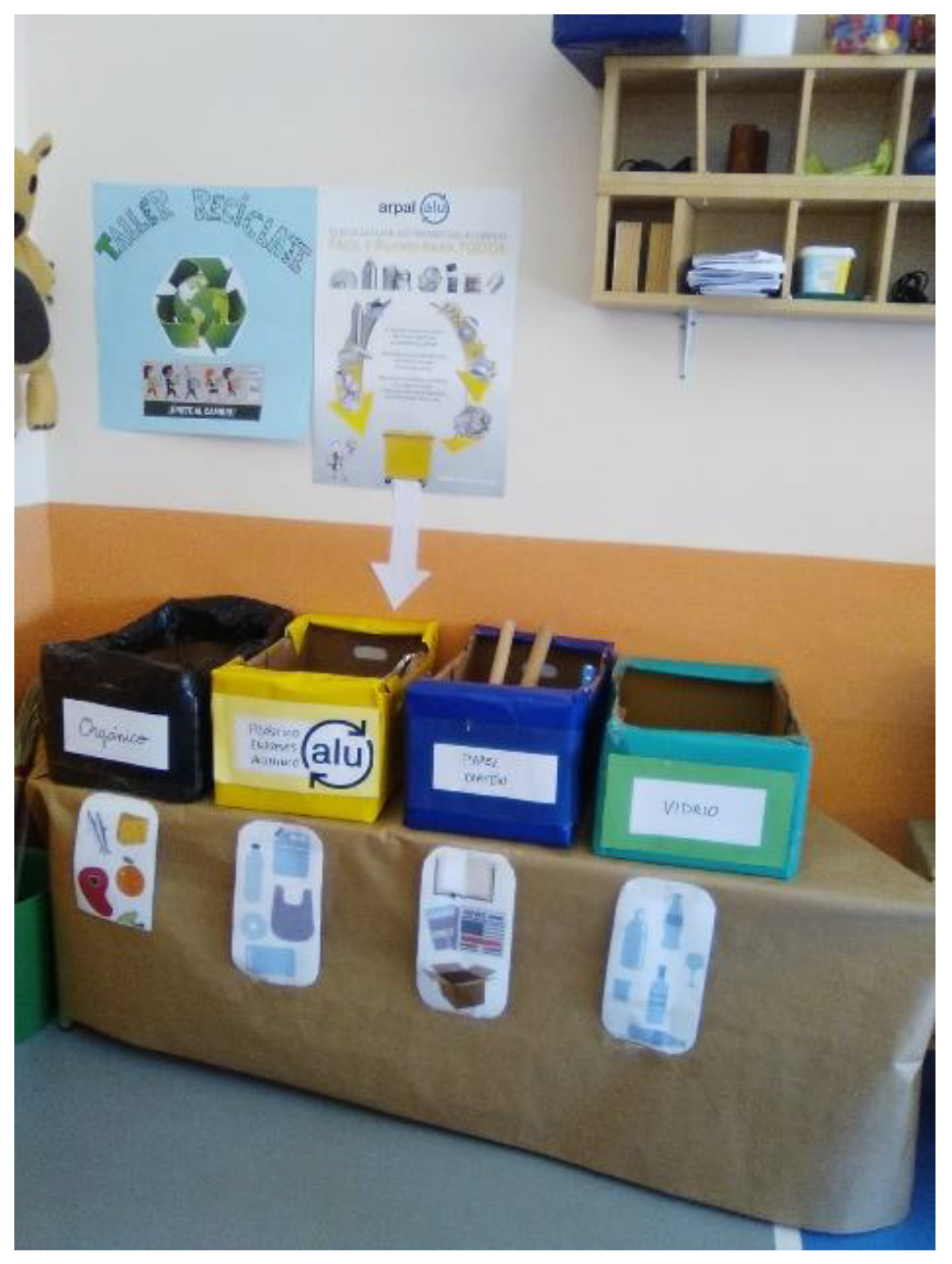
Figure A2. Selecting different packaging and throwing it in the correct container.
Figure A2. Selecting dissimilar packaging and throwing it in the right container.
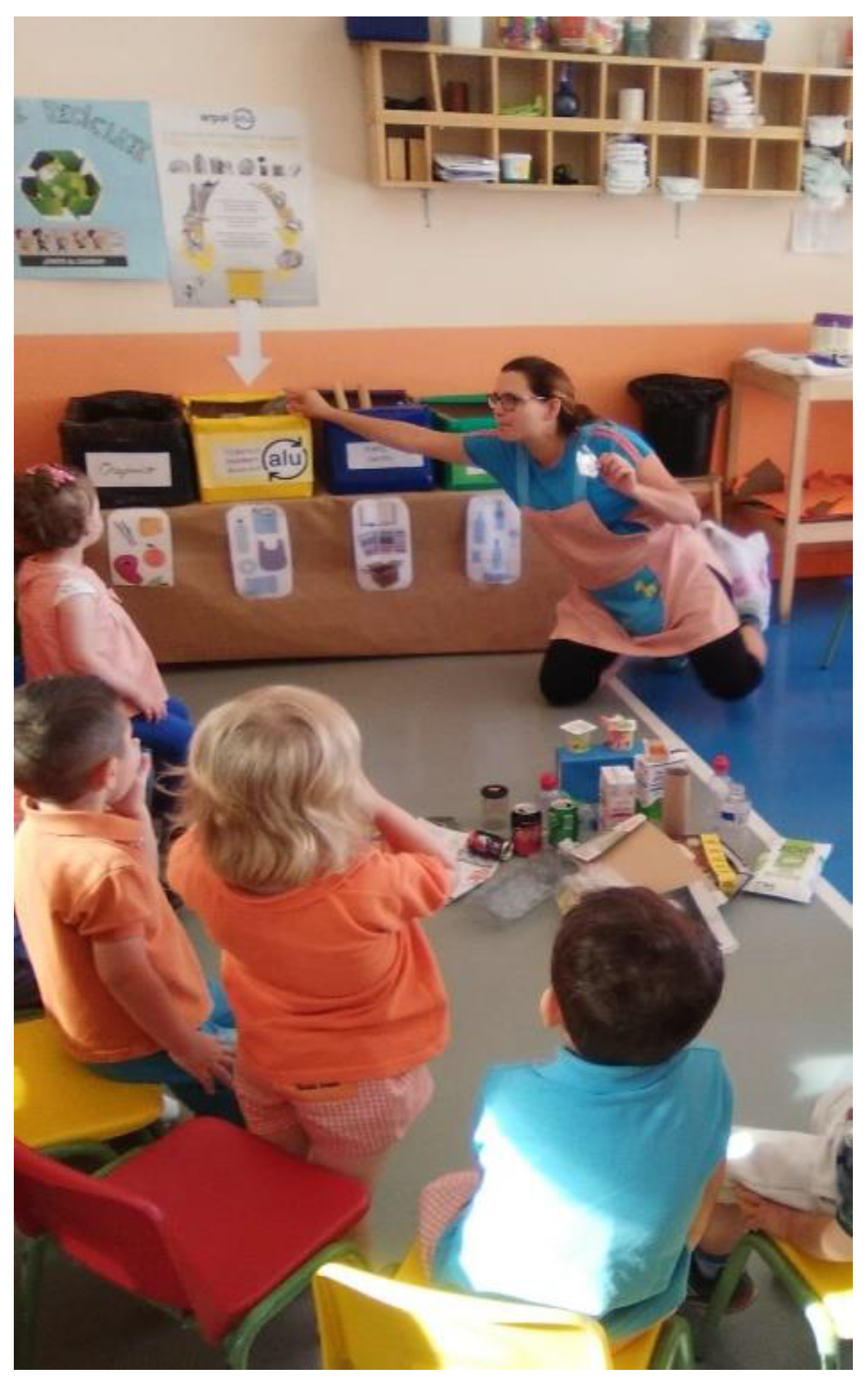
Effigy A3. Drawing a metallic effigy and sticking aluminum on information technology.
Figure A3. Drawing a metal figure and sticking aluminum on information technology.
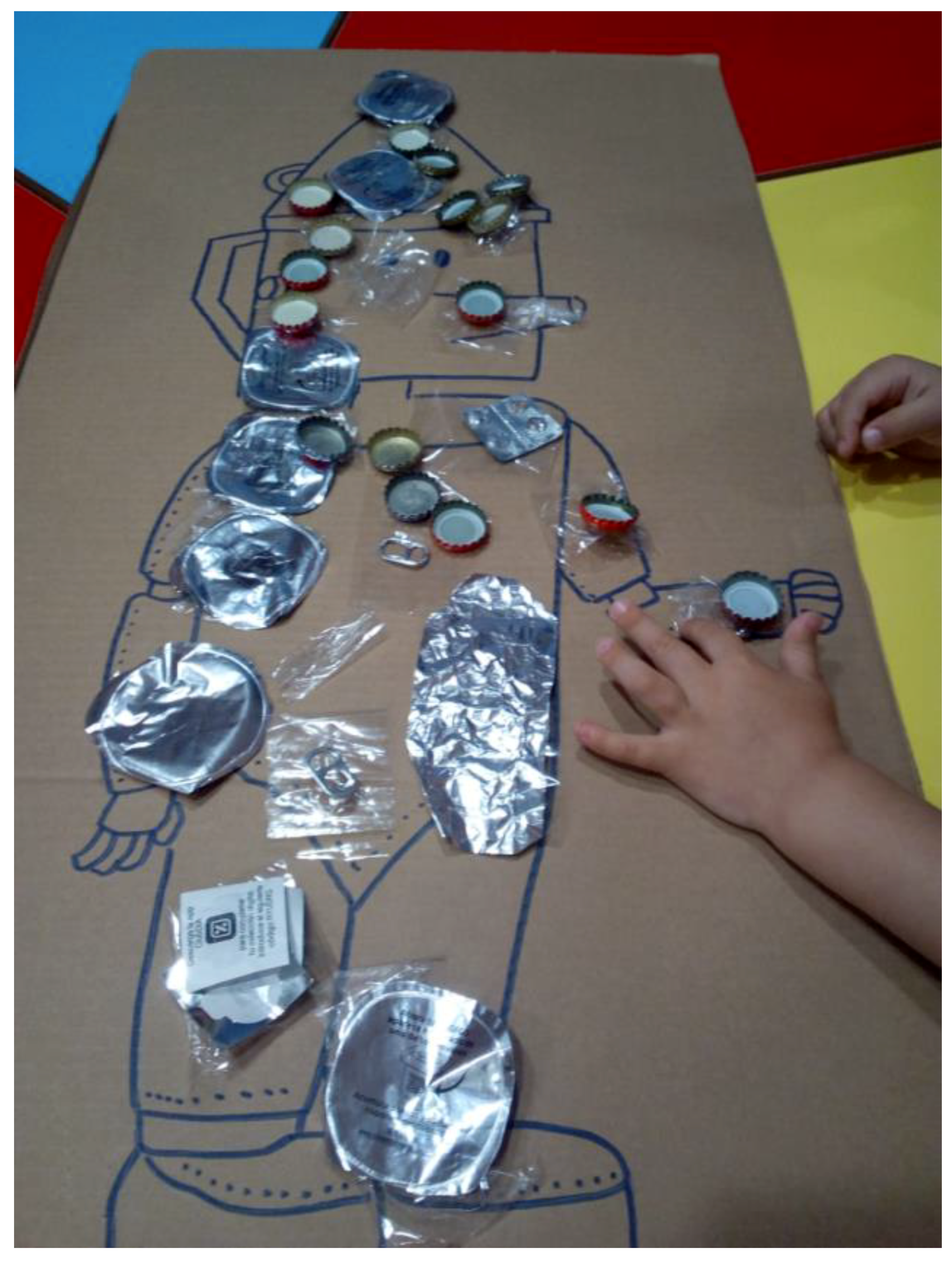
Figure A4. Selecting aluminum and metal packaging with a magnet.
Figure A4. Selecting aluminum and metal packaging with a magnet.
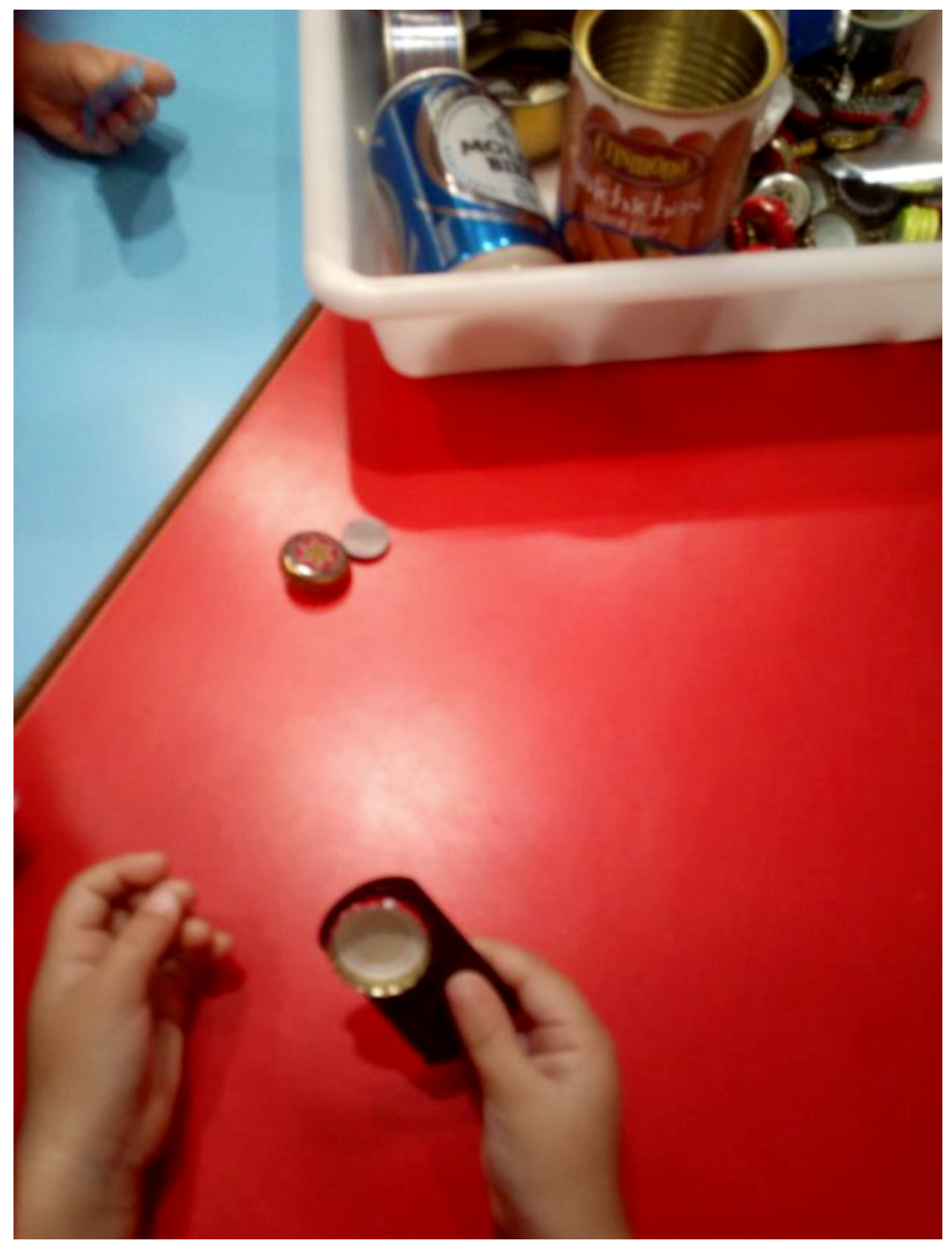
Figure A5. Creating a flowerpot with aluminum packaging, adding seeds, and watering it.
Figure A5. Creating a flowerpot with aluminum packaging, adding seeds, and watering it.
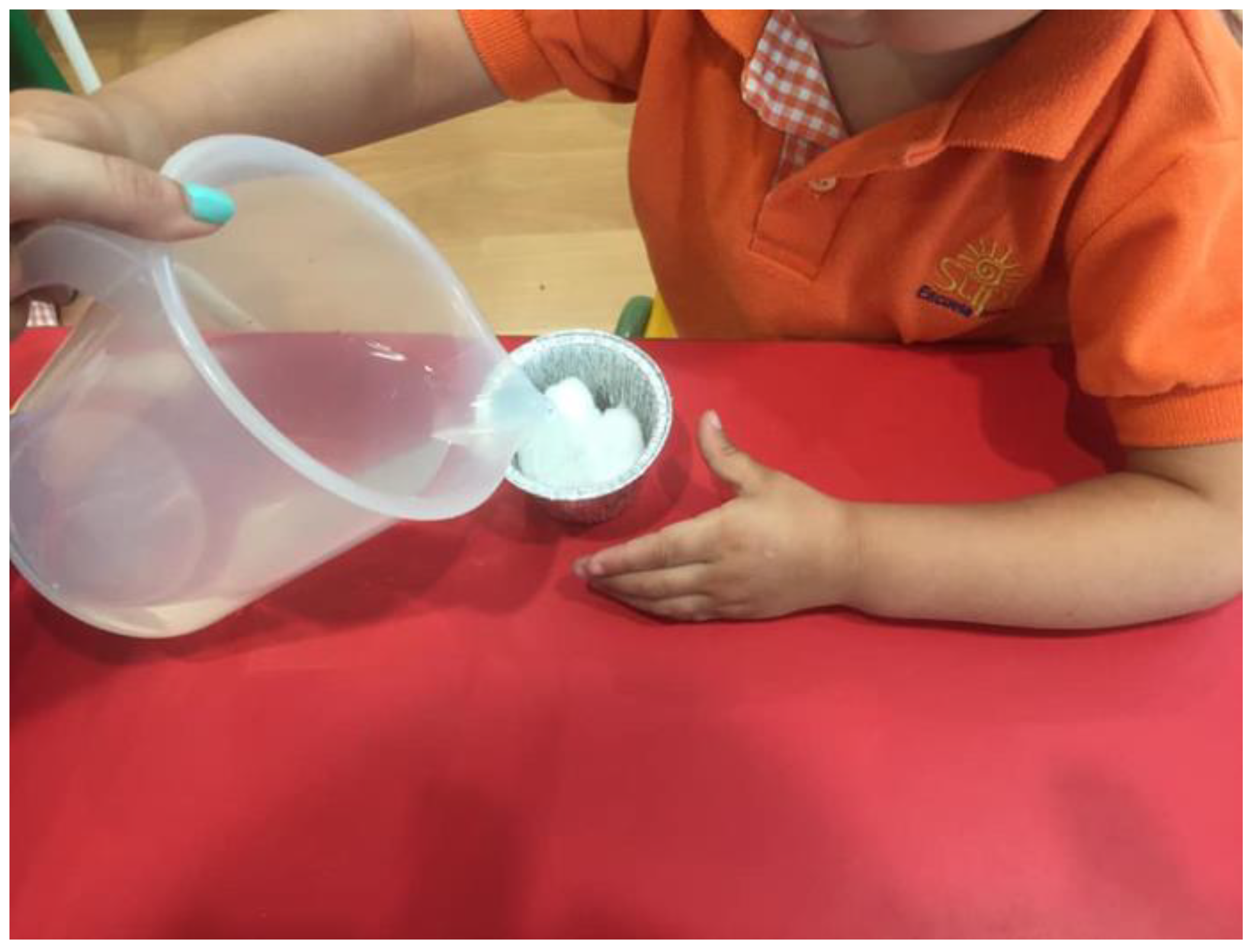
Effigy A6. Painting and drawing on aluminum foil with different tools.
Effigy A6. Painting and cartoon on aluminum foil with dissimilar tools.
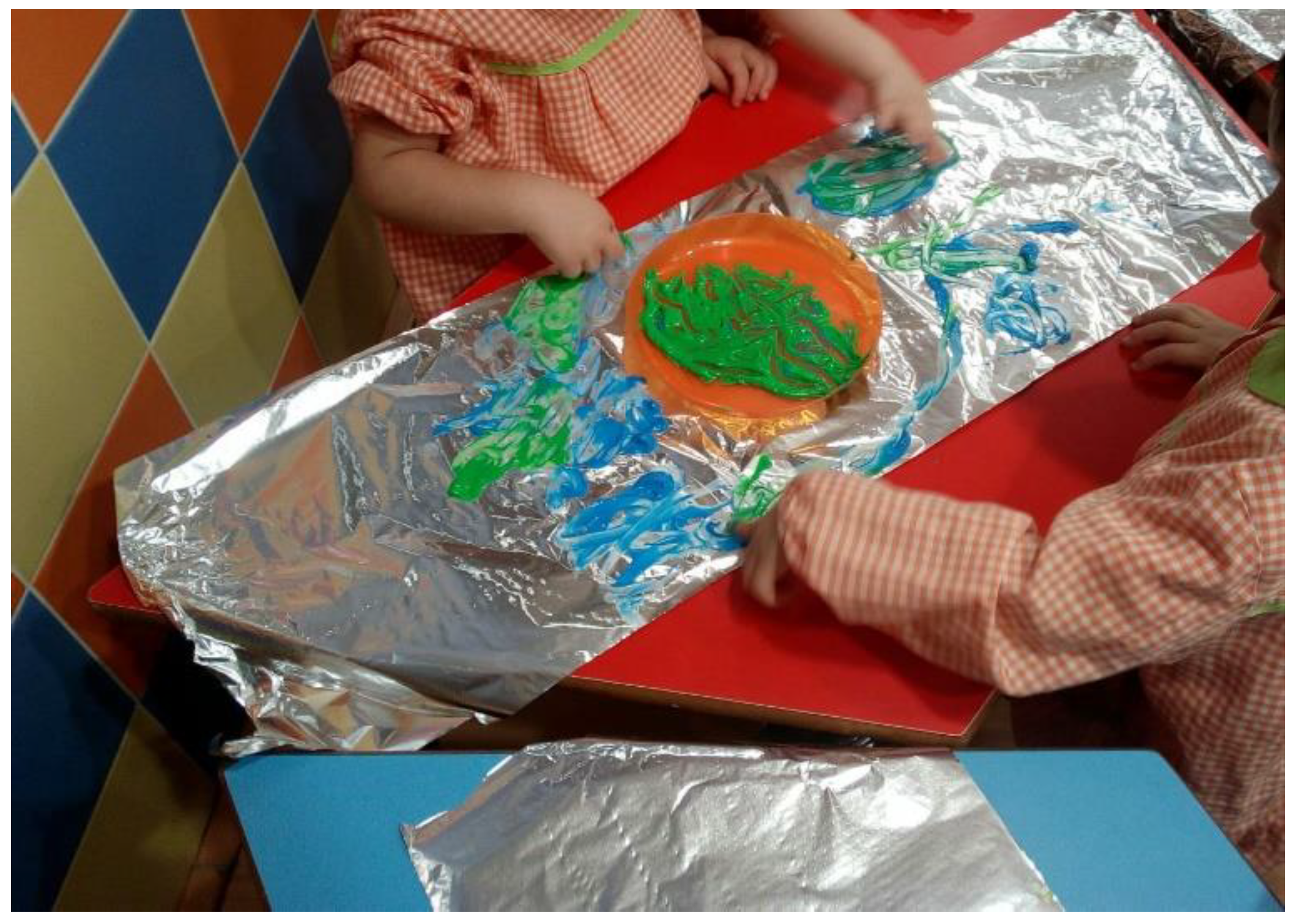
Figure A7. Designing a circuit made of aluminum packaging and other materials.
Effigy A7. Designing a circuit made of aluminum packaging and other materials.
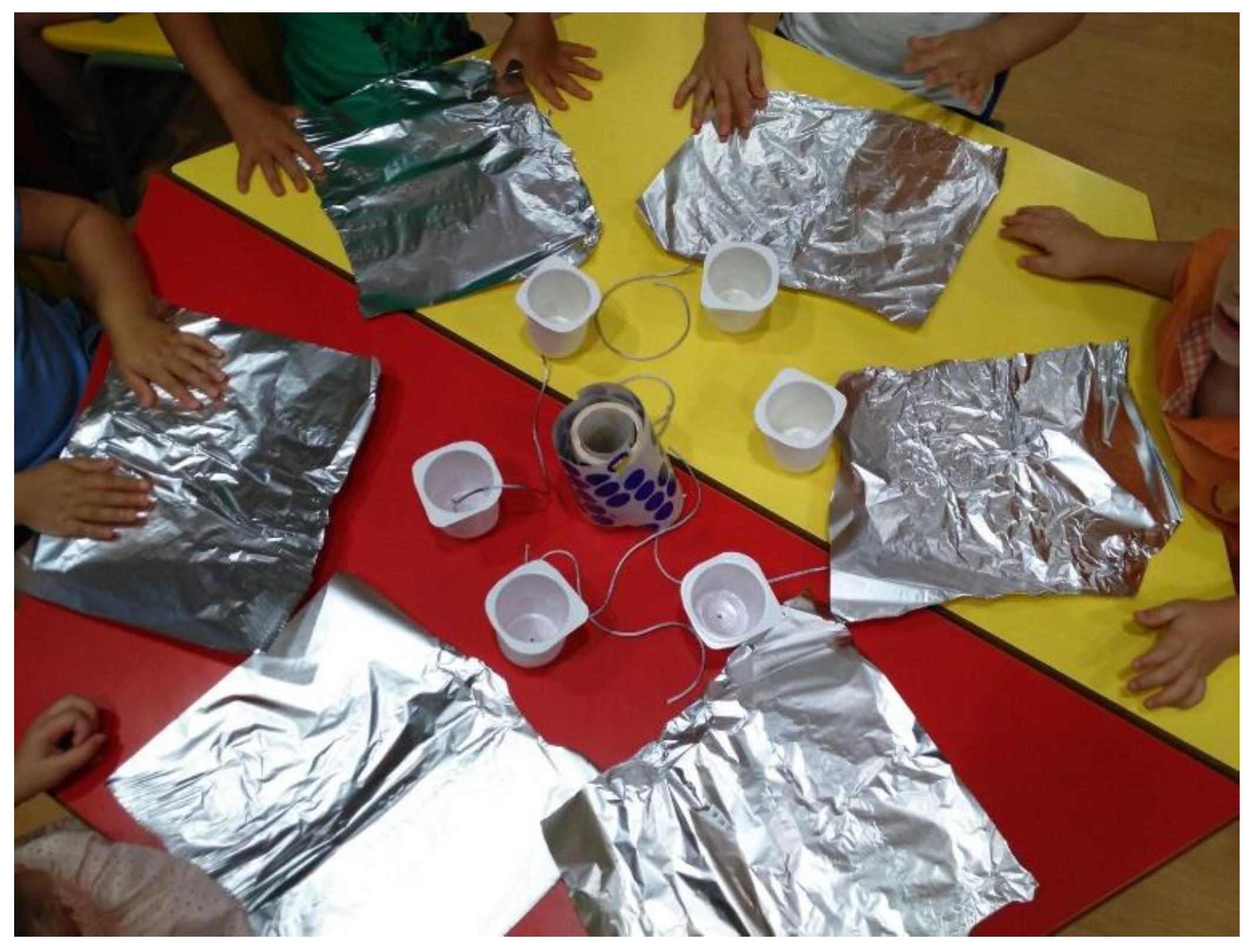
Figure A8. Visiting the recycling center.
Figure A8. Visiting the recycling center.
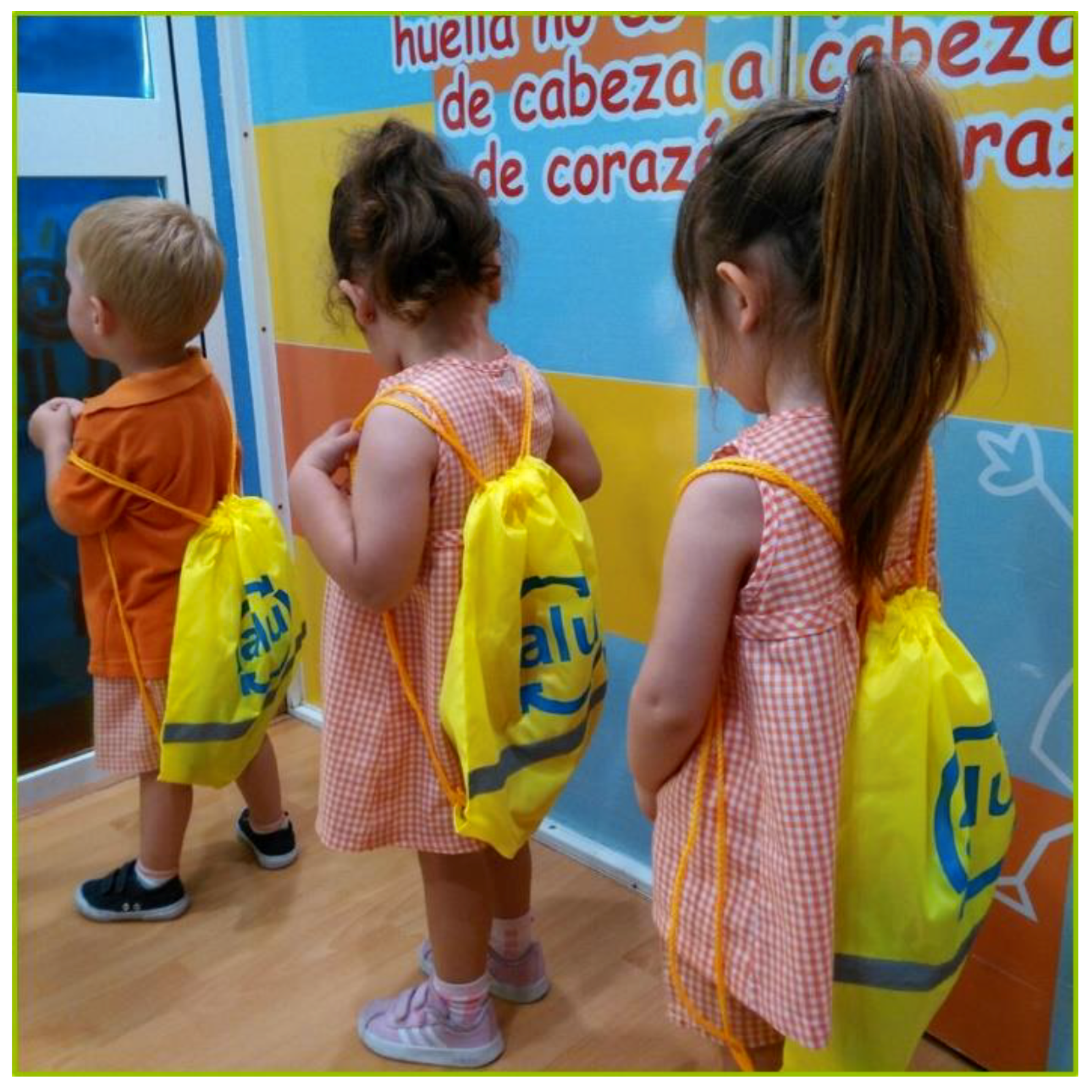
References
- Un. The Sustainable Development Goals Report 2016; United Nations: New York, NY, U.s.a., 2016. [Google Scholar]
- World Education Forum. Incheon Announcement and Framework for Activity for the Implementation of Sustainable Development Goal 4: Education 2030: Towards Inclusive and Equitable Quality Education and Lifelong Learning for All; UNESCO: Paris, France, 2015. [Google Scholar]
- United nations. Transforming Our earth: the 2030 Calendar for Sustainable Evolution; United Nations: New York, NY, USA, 2015; Available online: http://tinyurl.com/od9mens (accessed on 13 July 2018).
- Peter, B.C.; Joseph, P.W.; Arjen, E.J.W. Envisioning Futures for Ecology and Sustainability Pedagogy; Wageningen Academic Publishers: Wageningen, Kingdom of the netherlands, 2017. [Google Scholar]
- Hopwood, B.; Mellor, K.; O'Brien, G. Sustainable Development: Maping Unlike Approaches. Sustain. Dev. 2005, xiii, 38–52. [Google Scholar] [CrossRef]
- Fien, J. Education for Sustainability. In Studying Guild and Environment. A Guide for Teachers; Robert, G., Ed.; Thomson: South. Melbourne, Commonwealth of australia, 2004; pp. 184–200. [Google Scholar]
- María, A.Chiliad.Thou. Educating for local development and global sustainability: An overview in Spain. Sustainability 2009, 1, 479–493. [Google Scholar] [CrossRef]
- Julie, D.; Sue, E. (Eds.) Inquiry in Early Childhood Teaching for Sustainability; Routledge: Abingdon/London, Britain, 2014. [Google Scholar]
- Bob, K.; Bill, H.; Geoff, O. Environment, economic system and guild: fitting them together into sustainable development. Sustain. Dev. 2002, ten, 187–196. [Google Scholar]
- Khajuria, A. Resource efficiency: Progress and Challenges of 3Rs technologies and policies. WIT Trans. Ecol. Environ. 2016, 202, 57–lx. [Google Scholar]
- Iris, D. Making 'Identify' for Ecological Sustainability in Early Babyhood Education. Environ. Educ. Res. 2012, 18, 19–29. [Google Scholar]
- Davis, J.1000. oung Children and the Environment: Early on Educational activity for Sustainability; Cambridge University Press: Cambridge, UK, 2015. [Google Scholar]
- Sawitri, D.R. Education for Sustainable Evolution: How Early on is Also Early? Adv. Sci. Lett. 2017, 23, 2559–2560. [Google Scholar] [CrossRef]
- Loubser, C.; Yahya, N.A.; Johann, D.; Abdul, North.A. The effectiveness of environmental teaching workshops for teachers, learners and schools in Malasya. Environ. Dev. Sustain. 2014, 16, 1163–1176. [Google Scholar] [CrossRef]
- Young, Due west.; Kumju, H.; McDona, S.; Caroline, J.O. Sustainable consumption: Light-green consumer behaviour when purchasing products. Sustain. Devel. 2010, 18, 20–31. [Google Scholar] [CrossRef]
- Kollmuss, A.; Julian, A. Mind the Gap: Why do people act environmentally and what are the barriers to pro-environmental behavior? Environ. Educ. Res. 2013, eight, 239–260. [Google Scholar] [CrossRef]
- Chang, Y.J.; Laura, S.; Matthias, F. Assessing Child Development: A Disquisitional Review and the Sustainable Child Development Alphabetize (SCDI). Sustainability 2015, 7, 4973–4996. [Google Scholar] [CrossRef]
- Davis, J. Revealing the enquiry 'hole' of early childhood teaching for sustainability: A preliminary survey of the literature. Environ. Educ. Res. 2009, xv, 227–241. [Google Scholar] [CrossRef]
- Somerville, Thou.; Carolyn, Due west. Sustainability Education in Early Childhood: An Updated Review of Enquiry in the Field. Contemp Issues Early Child. 2015, 16, 102–117. [Google Scholar] [CrossRef]
- Iliopoulou, I. How immature children remember they tin can human activity for the surround: the case of forest and waste. Education 2018, 46, 249–263. [Google Scholar] [CrossRef]
- Directive (EU) 2018/852 of the European Parliament and of the Council of 30 May 2018 amending Directive 94/62/EC on packaging and packaging waste material. Bachelor online: https://eur-lex.europa.european union/eli/dir/2018/852/oj (accessed on 30 September 2018).
- Varela-Losada, M.; Arias-Correa, A.; Pérez-Rodríguez, U.; Vega-Marcote, P. How Can Teachers Be Encouraged to Commit to Sustainability? Evaluation of a Teacher-Preparation Experience in Espana. Sustainability 2019, 11, 4309. [Google Scholar] [CrossRef]
- Korkmaz, A.; Yildiz, T.G. Assessing preschools using the Eco-Schools programme in terms of educating for sustainable development in early babyhood education. Eur. Early. Child. Educ. Res. J. 2017, 25, 595–611. [Google Scholar] [CrossRef]
- Svetina, M.; Istenič-Starčič, A.; Juvančič, K.; Novljan, T.; Šubic-Kovač, Thou.; Verovšek, S.; Zupančič, T. How children come to understand sustainable development: A contribution to educational agenda. Sustain. Dev. 2013, 21, 260–269. [Google Scholar] [CrossRef]
- Pramling, S.I.; Carlsson, Thou.A. The playing learning child: Towards a instruction of early childhood. Scand. J. Educ. Res. 2008, 52, 52–641. [Google Scholar] [CrossRef]
- Pramling, Due north.; Doverborg, E.; Samuelsson, I.P. Re-metaphorizing Teaching and Learning in Early Childhood Teaching Beyond the Education–Social Fostering Split up. In Nordic Social Pedagogical Arroyo to Early Years; Charlotte, R., Kragh-Müller, One thousand., Eds.; Springer: Berlin, Frg, 2017. [Google Scholar] [CrossRef]
- Samuelsson, I.P. Why we should brainstorm early with ESD: The role of early childhood education. Int. J. Early. Child. Learn. 2011, 43, 103–118. [Google Scholar] [CrossRef]
- Samuelsson, I.P. What is the future of sustainability in early childhood? In The Sage Handbook of Early on Babyhood Research; Ann, F., Sharon, L.1000., Tisdall, E.M.G., Eds.; Sage: London, Great britain, 2016; pp. 502–516. [Google Scholar] [CrossRef]
- Taylor, Due north.; Frances, Q.; Chris, Due east. Educating for Sustainability in Main Schools: Education for the Future; Sense: Rotterdam, The netherlands, 2015. [Google Scholar] [CrossRef]
- Pramling Samuelsson, I.; Kaga, Y. The Contribution of early childhood pedagogy to a sustainable society. The Role of Early on Babyhood Education for a Sustainable Society, Göteborg, Sweden, 2007; UNESCO: Paris, French republic, 2008. [Google Scholar]
- Mackey, G. To know, to decide, to act: The young kid's right to participate in action for the surroundings. Environ. Educ. Res. 2012, xviii, 473–484. [Google Scholar] [CrossRef]
- Boyd, D. Early childhood education for sustainability and the legacies of two pioneering giants. Early Years 2018, 38, 227–239. [Google Scholar] [CrossRef]
- Luff, P. Early childhood education for sustainability: Origins and inspirations in the work of John Dewey. Education 2018, 46, 447–455. [Google Scholar] [CrossRef]
- Edwards, S.; Cutter-Mackenzie, A. 'Next Time We Can Be Penguins': Expanding the Concept of 'Learning Play' to Support Learning and Instruction nearly Sustainability in Early on Childhood Teaching. In Varied Perspectives on Play and Learning: Theory and Research on Early Years Pedagogy; Ole, F.L., Sue, D., Bob, P., Eds.; Information Age Publishing: Charlotte, NC, Usa, 2013; pp. 255–274. [Google Scholar]
- Samuelsson, I.P.; Park, East. How to Educate Children for Sustainable Learning and for a Sustainable World. Int. J. Early. Child. 2017, 49, 273–285. [Google Scholar] [CrossRef]
- MacDonald, M. Early Childhood Instruction and Sustainability: A Living Curriculum. Child. Educ. 2015, 91, 332–341. [Google Scholar] [CrossRef]
- Chauhan, Southward.; das, South.R.; Martin, H.; Natalia, R. Awareness vs Intentionality: Exploring Didactics for Sustainable Development in a British Hindu Community. Sustain. Dev. 2012, 20, 361–373. [Google Scholar] [CrossRef]
- Pollock, Thou.; Jane, D.W.; Peter, J.A. Inspiring environmentally responsible preschool children through the implementation of the National Quality framework: uncovering what lies between theory and practice. Aus. J. Early Child. 2017, 42, 12–19. [Google Scholar] [CrossRef]
- Hopkins, C.; McKeown, R. Moving Beyond the EE and ESD Disciplinary Fence in Formal Education. J. Educ. Sustain. Dev. 2017, i, 17–26. [Google Scholar] [CrossRef]
- Kennelly, J.; Neil, T.; Maxwell, T. A student teacher's personal pathway to educational activity for sustainability. Aust. J. Environ. Educ. 2008, 24, 23–33. [Google Scholar] [CrossRef]
- Hsiao, C.Y.; Pei, Y.S. Exploring the effectiveness of picture books for teaching young children the concepts of environmental protection. Int. Res. Geogr. Environ. Educ. 2016, 25, 36–49. [Google Scholar] [CrossRef]
- Buil-Fabregá, Yard.; Martínez, C.M.; Ruiz-Munzón, Due north.; Filho, W.50. Flipped Classroom as an Agile Learning Methodology in Sustainable Development Curricula. Sustainability 2019, xi, 4577. [Google Scholar] [CrossRef]
- Ballantyne, R.; John, F.; Jan, P. School environmental pedagogy programme impacts upon student and family learning: A case study analysis. Environ. Educ. Res. 2001, vii, 23–37. [Google Scholar] [CrossRef]
- Grodziéska-Jurczak, K.; Anna, South.A.; Katarzyna, N.K.; Bryda, G. Perception of Environmental Problems Among Pre-school Children in Poland. Int. Res. Geogr. Environ. Educ. 2006, fifteen, 62–76. [Google Scholar] [CrossRef]
- Seidman, I.E. Interviewing as Qualitative Research. A Guide for Researchers in Education and the Social Science; Teachers College Press: New York, NY, USA, 1998. [Google Scholar]
- Siraj-Blatchford, J.; Mogharreban, C.; Park, E. International Research on Education for Sustainable Development in Early Childhood; Springer: Cham, Switzerland, 2016; p. 14. [Google Scholar] [CrossRef]
- Hopkins, C. Scope and Impact of Global Deportment under UNDESD. J. Educ. Sustain. Dev. 2014, 8, 113–119. [Google Scholar] [CrossRef]
- Ärlemalm-Hagsér, Eastward.; Sue, E. Special Upshot: Gimmicky Research on Early Childhood Instruction for Sustainability. Int. J. Early Child. 2017, 49, 267–272. [Google Scholar] [CrossRef]
- Aznar, M.; Pilar, M.; Martinez-Agut, P.; Belen, P.; Albert, P.; Ull, M.A. Introducing sustainability into university curricula: An indicator and baseline survey of the views of university teachers at the University of Valencia. Environ. Educ. Res. 2011, 145–166. [Google Scholar] [CrossRef]
- Martínez, A.; Pilar, G.; Ull, Yard.A.; Pilar, A.One thousand. Education for sustainable evolution in early childhood education in Spain. Evolution, trends and proposals. Eur. Early on. Child. Educ. Res. J. 2014, 22, 213–228. [Google Scholar] [CrossRef]
Figure i. Position of "recycling" within the framework of sustainable evolution. Source: authors.
Figure ane. Position of "recycling" inside the framework of sustainable development. Source: authors.
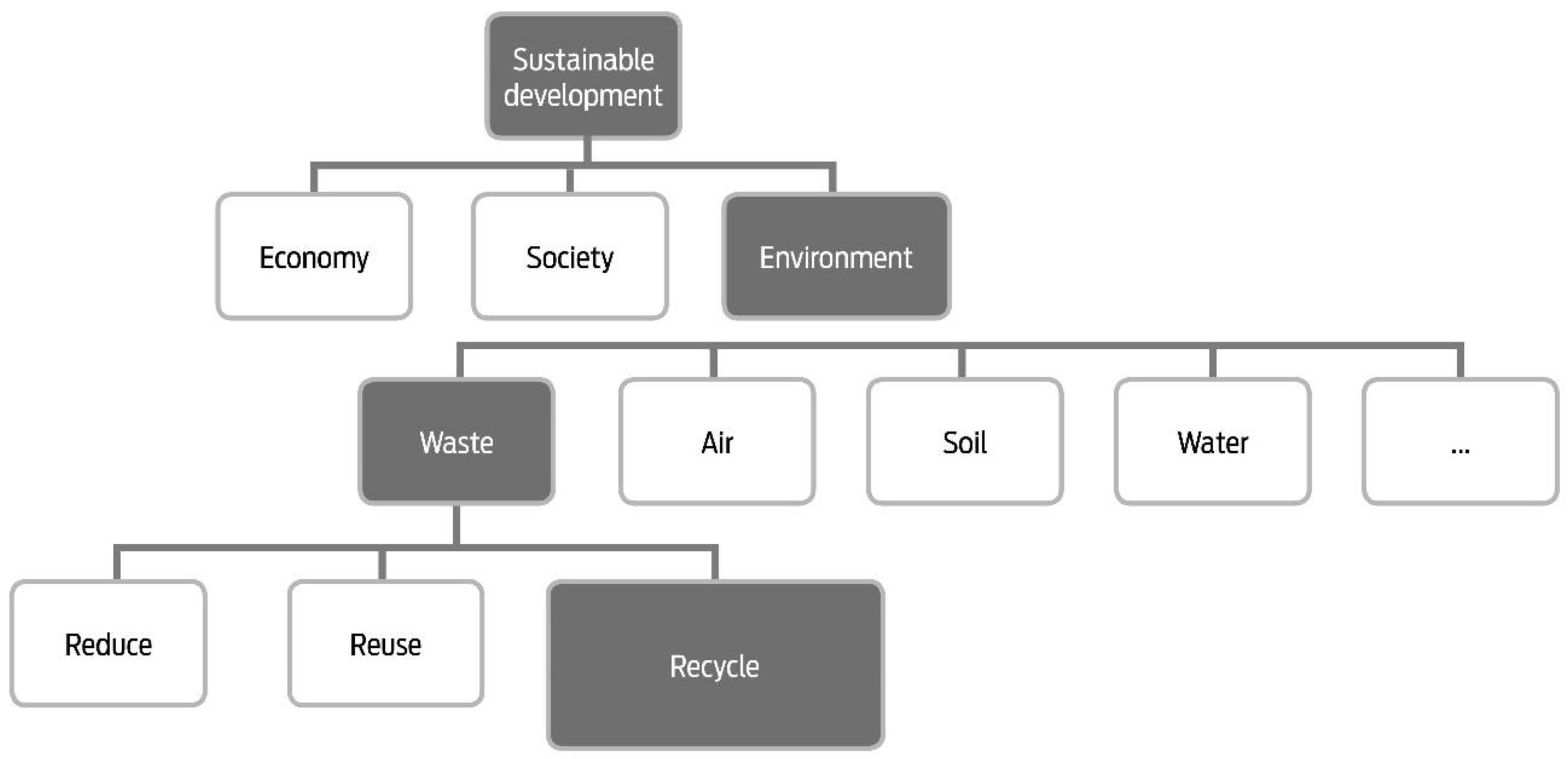
Effigy 2. Answer to the question, "Who benefits if yous recycle aluminum packaging?"
Figure 2. Answer to the question, "Who benefits if you lot recycle aluminum packaging?"
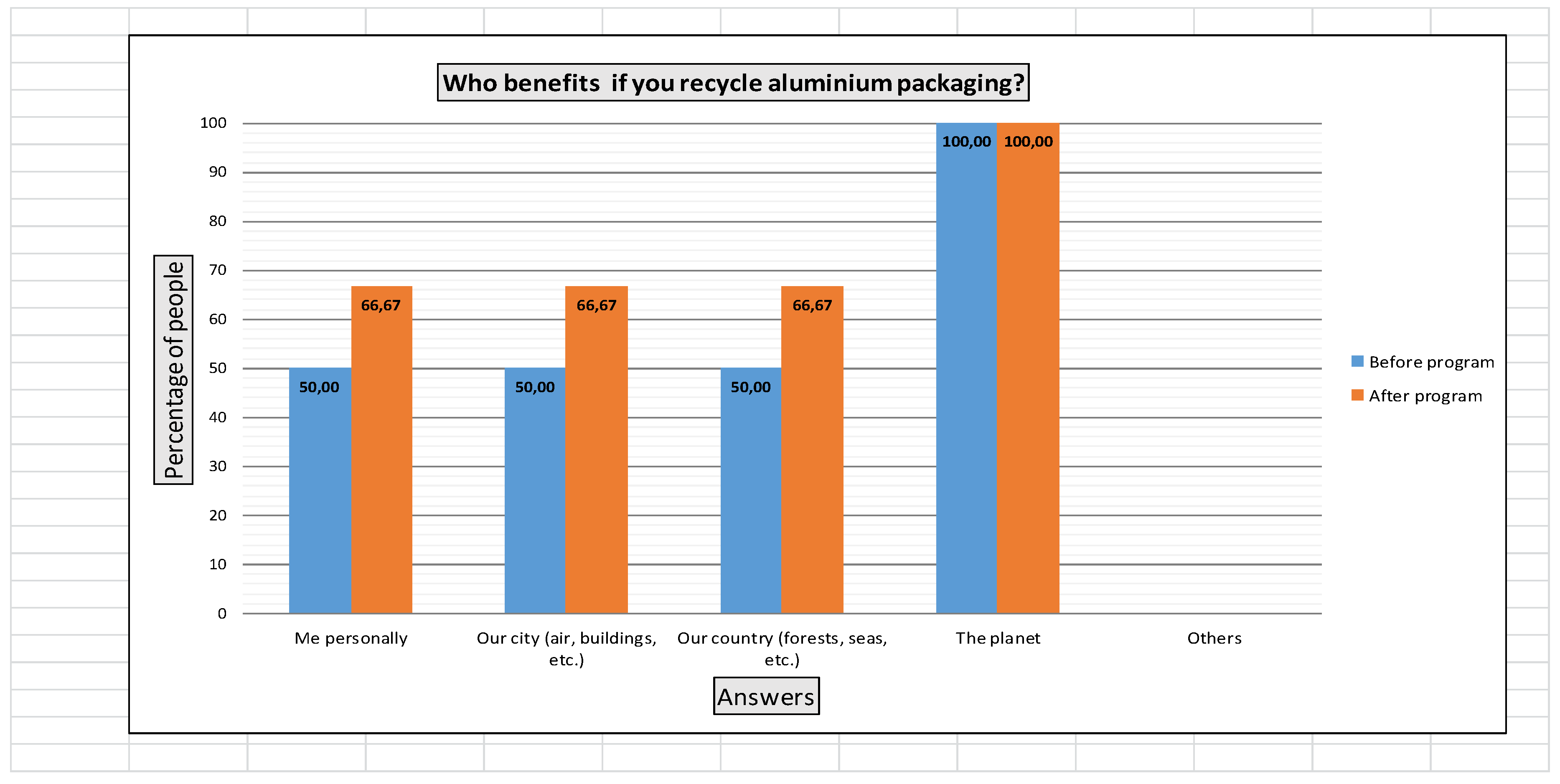
Figure three. Answer to the question, "Practice yous recycle some of the following materials at home or in the workplace?"
Figure 3. Respond to the question, "Practise you recycle some of the post-obit materials at domicile or in the workplace?"
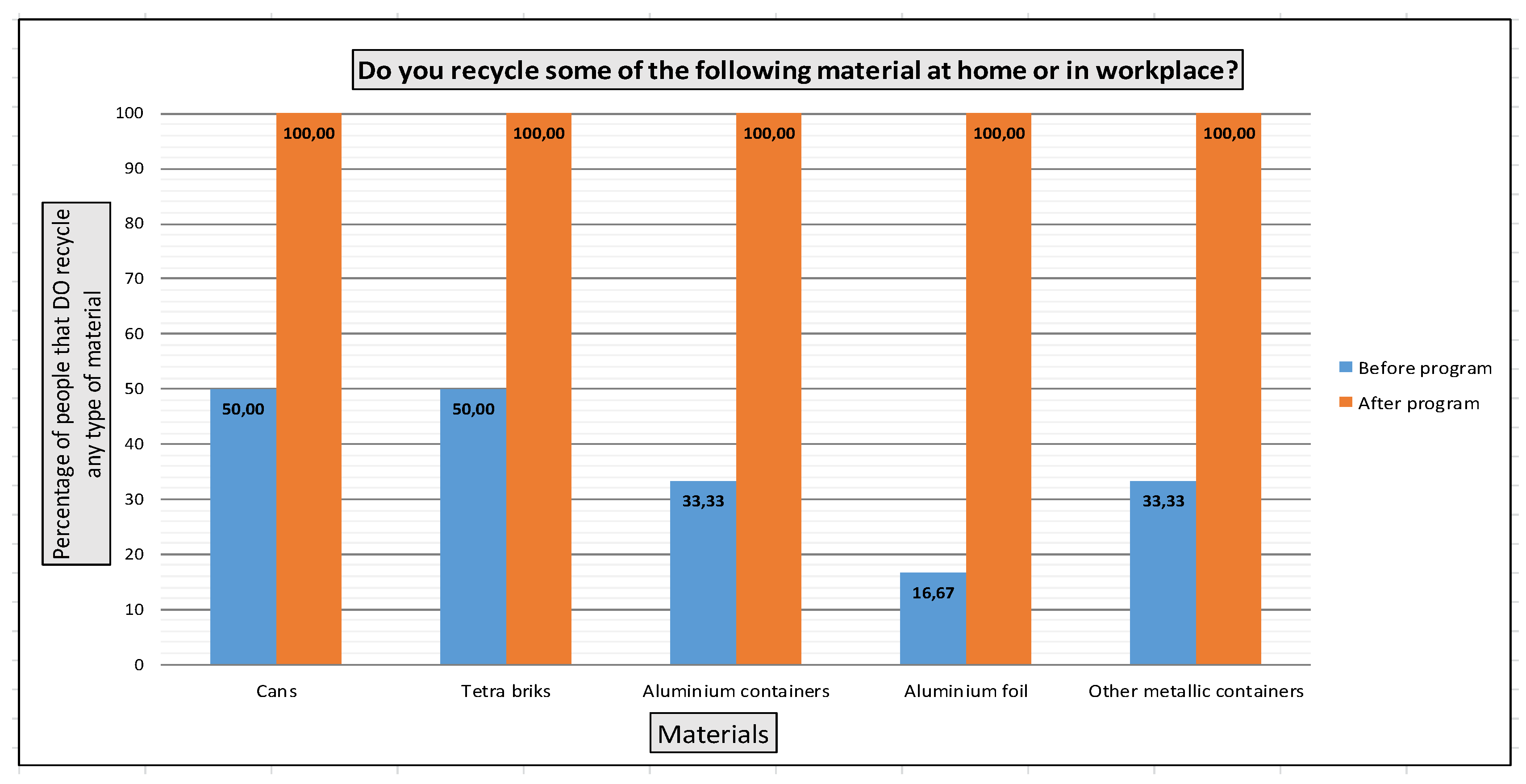
Figure iv. Answer to the question, "Do you teach near waste material recycling in the classroom?"
Figure iv. Answer to the question, "Do you lot teach nigh waste material recycling in the classroom?"
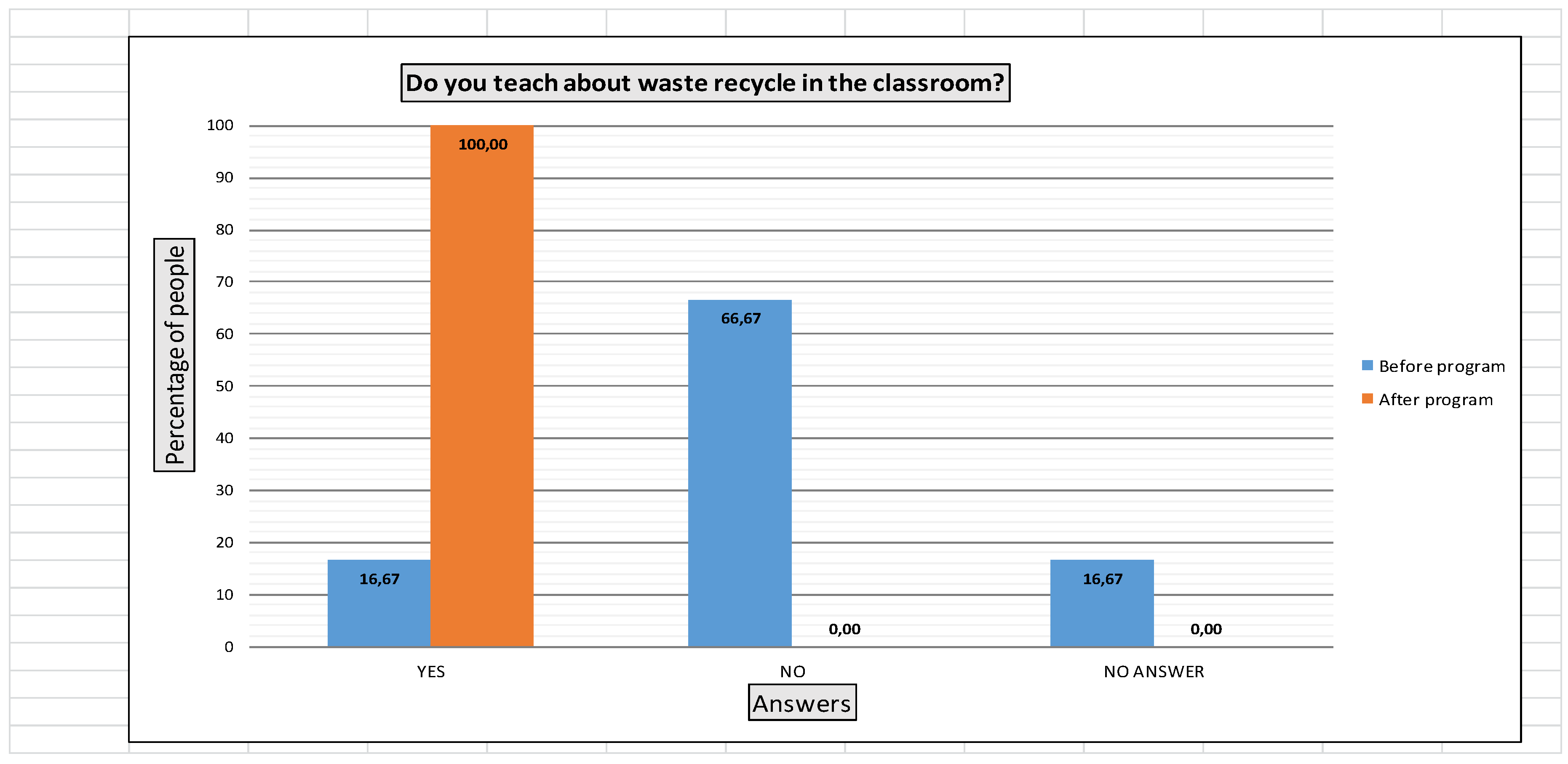
Figure 5. Answer to the question, "Could you mention packaging made of aluminum?".
Figure 5. Respond to the question, "Could you lot mention packaging fabricated of aluminum?".
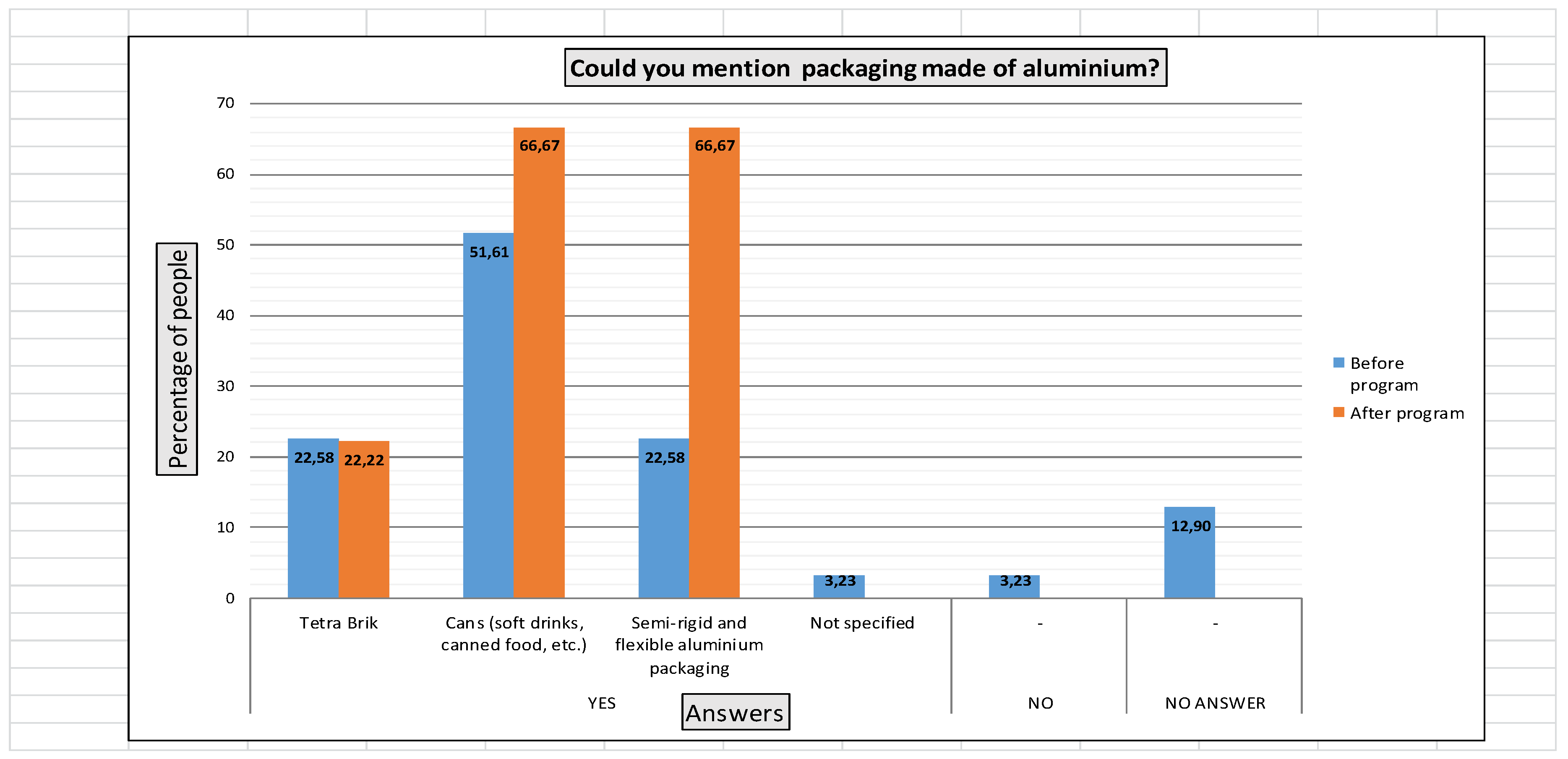
Figure half-dozen. Answer to the question, "How important do yous consider your participation in aluminum packaging recycling to exist?"
Figure 6. Answer to the question, "How important practise y'all consider your participation in aluminum packaging recycling to be?"
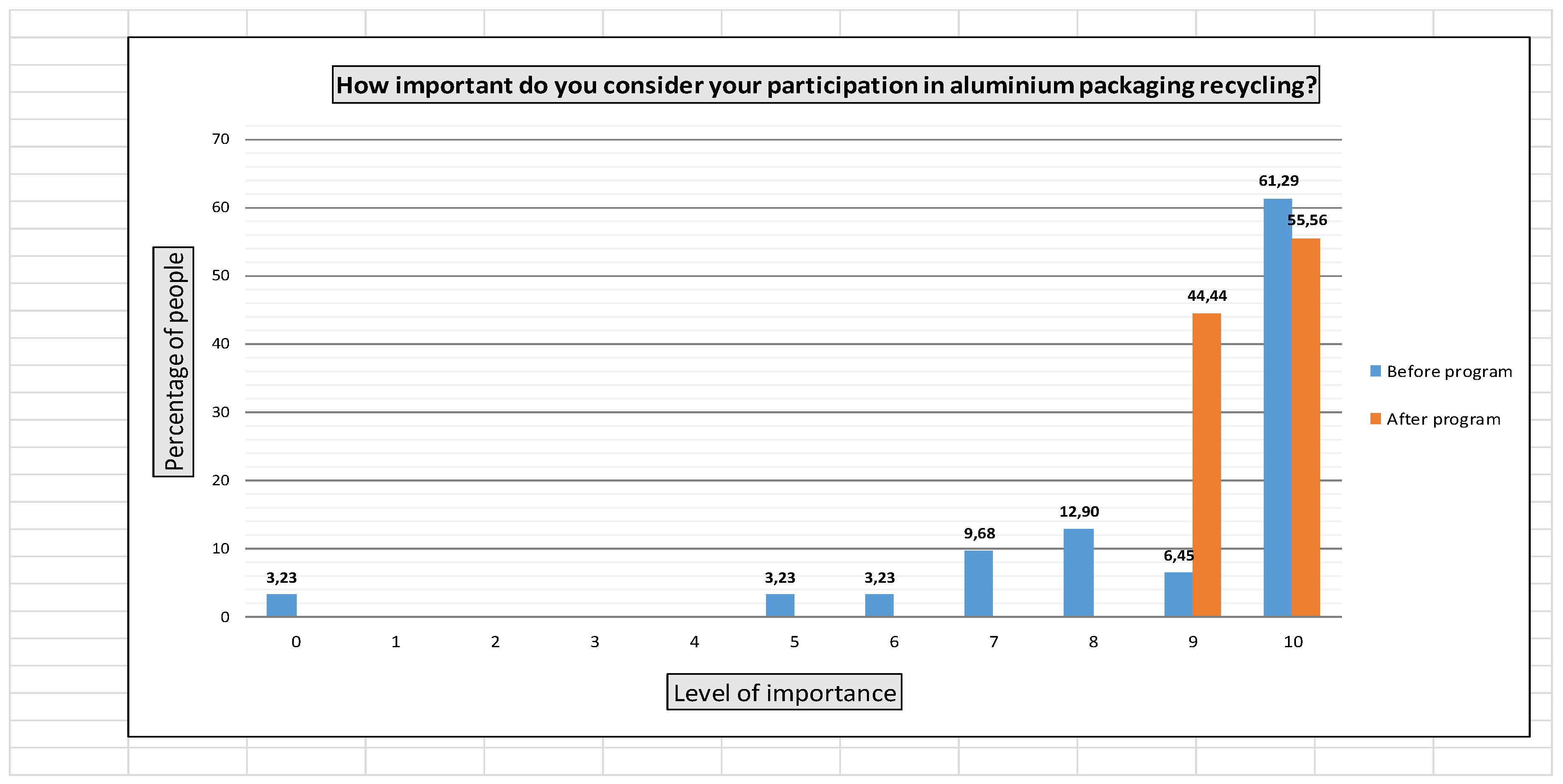
Figure 7. Reply to the question, "Who benefits if you lot recycle aluminum packaging?"
Figure 7. Answer to the question, "Who benefits if you recycle aluminum packaging?"
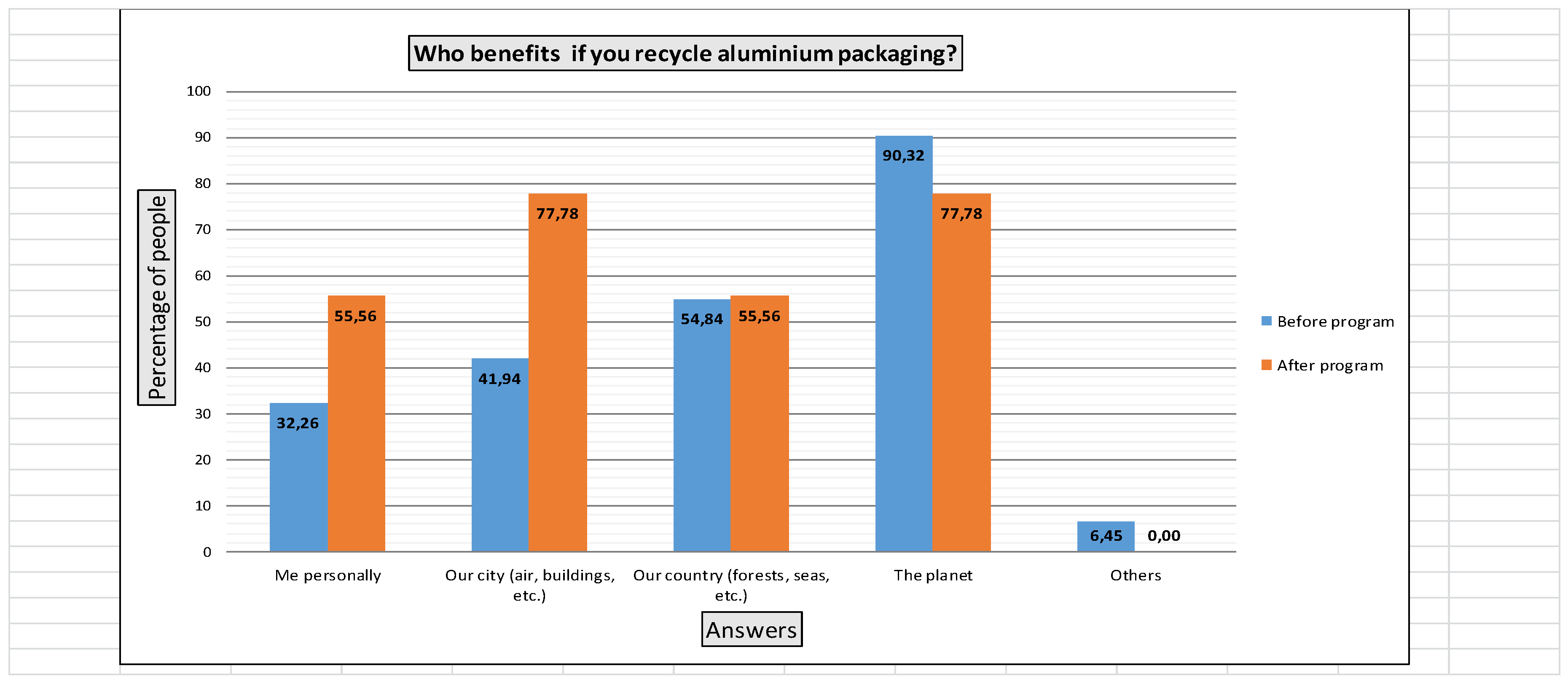
Figure 8. Respond to the question, "Exercise you recycle some of the following materials at home or in the workplace?"
Effigy viii. Answer to the question, "Do you recycle some of the following materials at abode or in the workplace?"
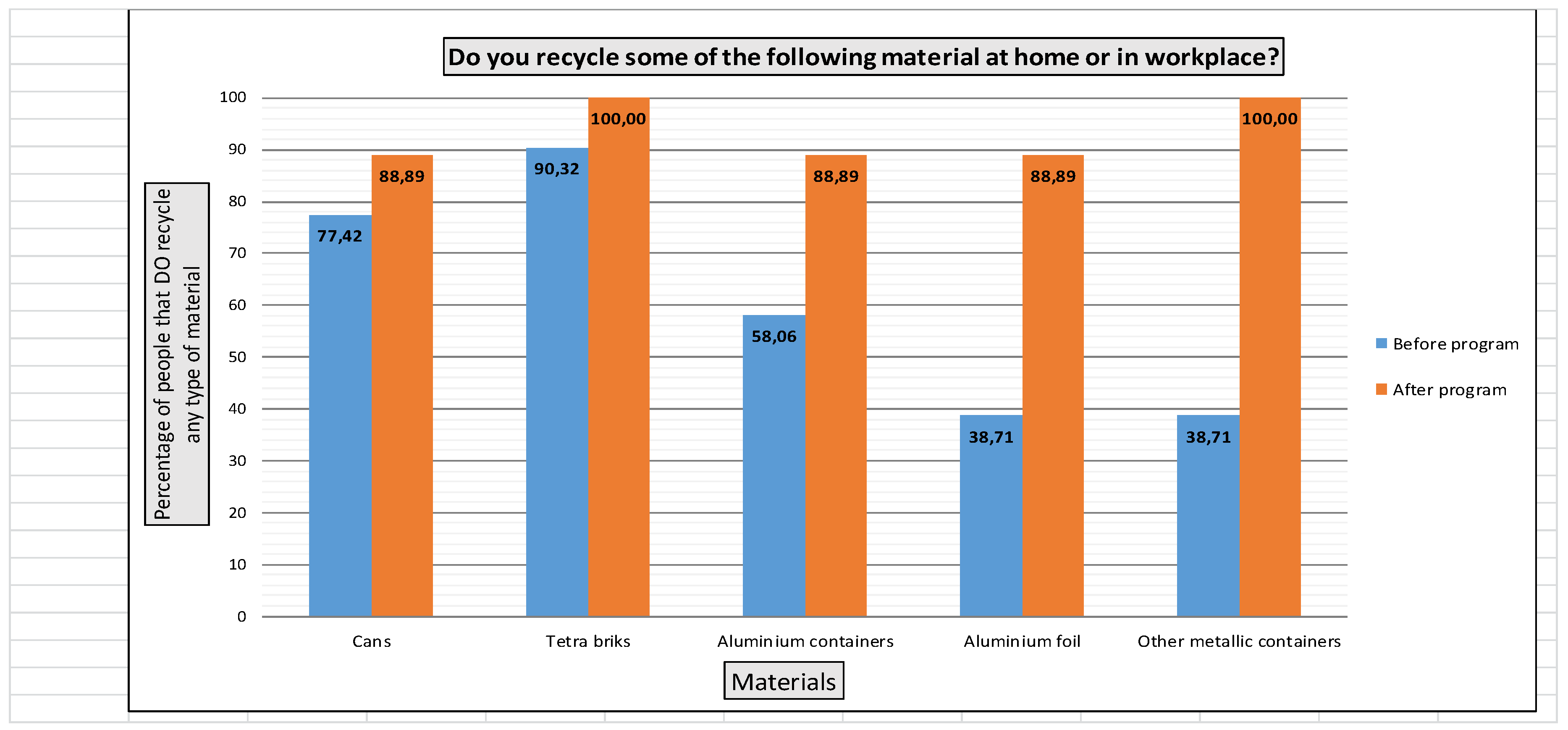
Tabular array ane. Activities of the education unit. Source: authors.
Table one. Activities of the didactics unit of measurement. Source: authors.
| 24-hour interval | Active Learning Strategies | Learning Activities |
|---|---|---|
| 1 | Initial activity: talking about recycling in full general | Brainstorming Promoting ideas Assembly |
| two | Knowledge activity and sensation: talking about colors of containers for recycling and what to throw in each i. Creation of a "Recycling Corner" with boxes and colors. See Effigy A1. | Discussions within the grade Knowledge through action |
| 3 | Selecting dissimilar packaging and throwing it in the right container. Come across Figure A2. | Classification workshop |
| 4 | Presenting "Sorcerer of Oz" story; drawing a metal figure and sticking aluminum in it. Run across Figure A3. | Creative workshop Interacting with their friends |
| v | Selecting aluminum and metal packaging with a magnet. See Figure A4. | Experimentation workshop |
| 6 | Out-of-form activities: seeing containers in the street and throwing aluminum packaging in the yellow container. | Experiential visit in collaboration with parents |
| 7 | Creating a flowerpot with aluminum packaging, adding seeds, and watering it. See Figure A5. | Creative and experimentation workshop |
| eight | Painting and drawing on aluminum foil with different tools (sponge, roller, and brush). See Figure A6. | Art and experimentation workshop |
| ix | Interacting with their teacher and friends: seeing and touching bauxite stone. | Sensory workshop (observation, manipulation, etc.). |
| x | Designing a circuit fabricated of aluminum packaging and other materials such as balls, strings, etc.; imitating characters of "Magician of Oz" story. Run across Figure A7. | Dramatization Creative and psychomotor workshop |
| 11 | Out-of-grade activeness: visit to the recycling eye in Sadeco. See Effigy A8. | Experiential visit in collaboration with parents |
| 12 | Creating a "hungry hungry hippos" toy and throwing balls made of aluminum packaging. | Cosmos Gamification Playing |
| 13 | Designing a collar made of aluminum caps. | Art workshop |
| 14 | Interacting with their teacher and friends: boob prove about "Wizard of Oz" story. | Dramatization |
| 15 | Final activity: repeating the initial activities to assess the learning process. | Brainstorming Assembly |
Table ii. Steps, groups involved, dates, and techniques that were used in the research. Source: authors.
Table 2. Steps, groups involved, dates, and techniques that were used in the research. Source: authors.
| Steps | Groups Involved | Appointment | Actions |
|---|---|---|---|
| Cooperation agreement and working program | Arpal clan Supla association | June 2017 September–October 2017 | Meetings Brainstorming Commitment |
| Training of teachers | 7 teachers from Córdoba and Seville and Arpal | Nov 2017 | Lecture and active session about aluminum packaging and its recyclability |
| Pre- and post-assessment of noesis, awareness, and deportment regarding recycling | Seven teachers | Nov 2017 | Quantitative: Questionnaire pre- and post-preparation |
| Blueprint of a instruction unit most aluminum packaging recycling for children under 6 years old | Teachers and Arpal | February–May 2018 | fifteen active learning activities involving children, volunteer parents, and the neighborhood |
| Find out the pre-level of knowledge, awareness, and actions regarding recycling | Parents of 54 children in Córdoba and Seville | ane–x June 2018 | Quantitative: pre-activity questionnaire |
| Implementation of the teaching unit in a pilot test | 2 preschools in Córdoba, ane in Seville (54 children in total): Centro de Ed Inf Supli Sur (Córdoba), Centro de Ed Inf Supli Levante (Córdoba), and Centro de Ed Inf Supli Sevilla (Seville) | 11–22 June 2018 | Active learning fostering multiple intelligences Observation Parents' participation |
| Assessment of the pilot test Review of the initial teaching unit of measurement and realization of the last educational activity unit | Seven teachers | 23 June–7 July 2018 | Observations of teachers/development of activities/observations from parents |
| Cess of how the program affected the whole family | Parents of 54 children in Córdoba and Seville | 23 June–7 July 2018 9 July 2018 | Quantitative: post-questionnaires and in-depth interview |
| Final assessment of the plan and its impact on the preschool community | Teachers and managers | x July 2018 | Qualitative: focus grouping |
| Implementation of the concluding teaching unit | 29 preschools in Córdoba and the Cádiz region (1300 children) | vii July 2018 to the stop of the month | Active learning fostering multiple intelligences |
© 2019 by the authors. Licensee MDPI, Basel, Switzerland. This article is an open admission commodity distributed under the terms and conditions of the Creative Eatables Attribution (CC Past) license (http://creativecommons.org/licenses/by/4.0/).
Source: https://www.mdpi.com/2071-1050/11/22/6393/htm
0 Response to "A Leyyer to Families on Recycling for Teaching Strategies"
Post a Comment